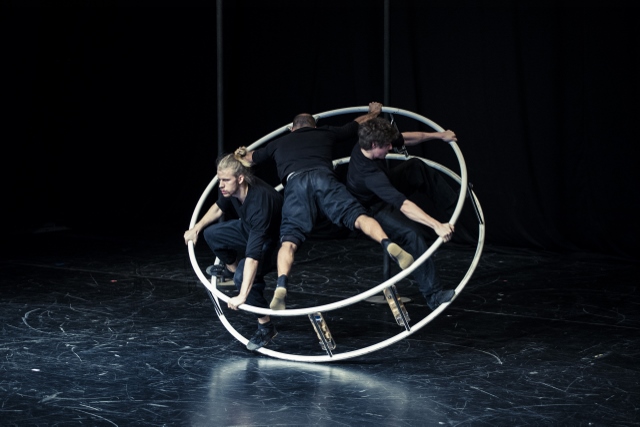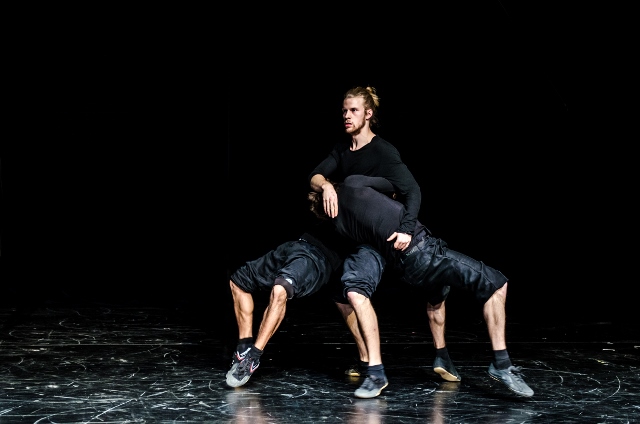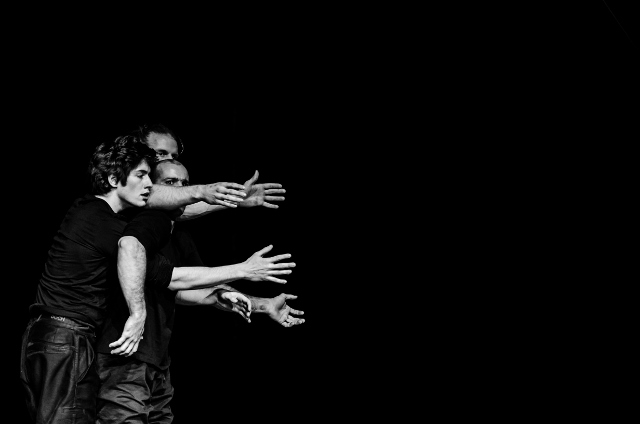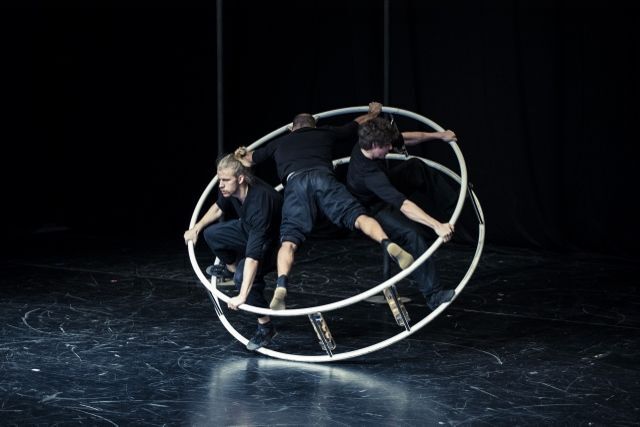 It is not easy to distinguish new circus from physical or dance theatre as the differences are sometimes hard to spot. Dance movements penetrate acrobatics, and vice versa, spoken word emerges from time to time. The human body, as an extremely versatile instrument, links dance to new circus more than to any other kind of performing art. The body and physical intimacy appears in new circus as a motif, too, and become subjects to artistic research and experiments. One of the contemporary streams of new circus is determined, as for its motifs and content, by the human body. This trend seems to be detached from global political and social issues, it is also far from deep philosophical thoughts which only rarely result in more than a toothless cliché. The creative work is no longer based on what goes beyond the individual artists or a small group of acrobats but rather on what unites them. Friendship, confidence, talent, life energy, creativity and desire to experiment with what they know and are capable of.
It is not easy to distinguish new circus from physical or dance theatre as the differences are sometimes hard to spot. Dance movements penetrate acrobatics, and vice versa, spoken word emerges from time to time. The human body, as an extremely versatile instrument, links dance to new circus more than to any other kind of performing art. The body and physical intimacy appears in new circus as a motif, too, and become subjects to artistic research and experiments. One of the contemporary streams of new circus is determined, as for its motifs and content, by the human body. This trend seems to be detached from global political and social issues, it is also far from deep philosophical thoughts which only rarely result in more than a toothless cliché. The creative work is no longer based on what goes beyond the individual artists or a small group of acrobats but rather on what unites them. Friendship, confidence, talent, life energy, creativity and desire to experiment with what they know and are capable of.The Swedish company Sisters exemplifies such a way of artistic collaboration. It is formed by three acrobats – the French Valia Beauvieux, Danish Mikkel Hobitz Filtenborg and Spanish Pablo Rada Moniz; the team also includes the Norwegian technician and light designer Bjørn Olav Hauknes.
 As its very first production, the Sisters company presented a piece called Clockwork. The three acrobats, who have recently graduated from Stockholm’s Dans-och-circushögskolan, enjoyed success with some of their previous pieces at international circus contests and other international projects (e.g. Circus Next). This year in December, they came to perform Clockwork in Prague’s Jatka78.
The Sisters put everything that is at their disposal into their first choreographic work. Rather unconventionally, at least for today’s taste, they opt for multidisciplinary approach. The content of the piece is obviously based on the extraordinary physical skills of the three performers. That is why the choreographic composition gives stronger impression than the dramaturgic one. The piece is a collage made of acrobatic, mime and musical numbers. The basic material for building the individual choreographies was the artists’ ability to perform new routines on tools such as Chinese poles, gymnastic wheel and loose rope. The traditional circus elements are thus transformed into new ones, as the acrobats are able to set them into a time frame. It is then possible to create situations with diverse levels of dynamism and manifold meanings.
In Clockwork, the ever-changing dynamism goes hand in hand with changing light and sound intensity (music as well as sounds made with various instruments) and altering circus disciplines, from elegant floor acrobatics solo to challenging duos and trios on Chinese poles and a gymnastic wheel. In a rather showy way, the company plays with contrasts they find inside their own bodies and in the confrontation of force. They move together in the air and on the ground. Their bodies cannot be separated. One is chasing another and when the third one changes direction, the rest of the group change it, too. You never know who’ll take the leading role.
As its very first production, the Sisters company presented a piece called Clockwork. The three acrobats, who have recently graduated from Stockholm’s Dans-och-circushögskolan, enjoyed success with some of their previous pieces at international circus contests and other international projects (e.g. Circus Next). This year in December, they came to perform Clockwork in Prague’s Jatka78.
The Sisters put everything that is at their disposal into their first choreographic work. Rather unconventionally, at least for today’s taste, they opt for multidisciplinary approach. The content of the piece is obviously based on the extraordinary physical skills of the three performers. That is why the choreographic composition gives stronger impression than the dramaturgic one. The piece is a collage made of acrobatic, mime and musical numbers. The basic material for building the individual choreographies was the artists’ ability to perform new routines on tools such as Chinese poles, gymnastic wheel and loose rope. The traditional circus elements are thus transformed into new ones, as the acrobats are able to set them into a time frame. It is then possible to create situations with diverse levels of dynamism and manifold meanings.
In Clockwork, the ever-changing dynamism goes hand in hand with changing light and sound intensity (music as well as sounds made with various instruments) and altering circus disciplines, from elegant floor acrobatics solo to challenging duos and trios on Chinese poles and a gymnastic wheel. In a rather showy way, the company plays with contrasts they find inside their own bodies and in the confrontation of force. They move together in the air and on the ground. Their bodies cannot be separated. One is chasing another and when the third one changes direction, the rest of the group change it, too. You never know who’ll take the leading role.
One of the performers always suddenly usurps the dominant position. It is especially obvious when they all climb Chinese poles. In the first half of the show, one of those poles is affixed to a giant wooden arm that the men – one by one and in various directions and paces – push
 around. It then resembles a huge scythe reaping all that comes to be around. The men must follow its movement and lie down to the ground like leaves of grass after a heavy rain. They try to escape the revolving threat and find refuge on the poles, jumping from one to another as if running away from the others. Sometimes they use their bodies as a support, sometimes they struggle for some space. Mutual help is replaced by fighting for survival and malicious spites. The contradictory and fickle acts of all the three acrobats are funny, thrilling and fear-evoking.
Dynamic and risky-so-dramatic moments alternate with much more intimate situations. For example, the scene in which Mikkel Hobitz Filtenborg hangs by his hair on a rope in half-darkness, in empty space, pants at his ankles. His body is slowly turning around its own axe, completely naked and without any shame it lets itself be spot-lit by a narrow beam. The situation seems neither vulgar or embarrassing nor funny. Although the young man is hanging by his hair, within a few minutes we stop concentrating on the pain he must be experiencing, and we only feel the time – slowing down.
Clockwork is an hour’s still-stand in an ordinary day, rapture of banality, showcase of physical perfection and flawless coordination of three bodies. Physical power and energy that each of the three men radiates is invigorating.
Clockwork
Authors/artists: Valia Beauvieux (France), Mikkel Hobitz Filtenborg (Denmark), Pablo
Rada Moniz (Spain)
Light design: Bjorn Olav Hauknes
Sound, live music: Dimitris Papaioannou, Girwrgos Po
ulios, Mikkel Hobitz Filtenborg
Costumes: Nadia Leon
Technician: Bjorn Olav Hauknes
Production: Peggy Donk
Author: Veronika Štefanová
Theatre publicist
around. It then resembles a huge scythe reaping all that comes to be around. The men must follow its movement and lie down to the ground like leaves of grass after a heavy rain. They try to escape the revolving threat and find refuge on the poles, jumping from one to another as if running away from the others. Sometimes they use their bodies as a support, sometimes they struggle for some space. Mutual help is replaced by fighting for survival and malicious spites. The contradictory and fickle acts of all the three acrobats are funny, thrilling and fear-evoking.
Dynamic and risky-so-dramatic moments alternate with much more intimate situations. For example, the scene in which Mikkel Hobitz Filtenborg hangs by his hair on a rope in half-darkness, in empty space, pants at his ankles. His body is slowly turning around its own axe, completely naked and without any shame it lets itself be spot-lit by a narrow beam. The situation seems neither vulgar or embarrassing nor funny. Although the young man is hanging by his hair, within a few minutes we stop concentrating on the pain he must be experiencing, and we only feel the time – slowing down.
Clockwork is an hour’s still-stand in an ordinary day, rapture of banality, showcase of physical perfection and flawless coordination of three bodies. Physical power and energy that each of the three men radiates is invigorating.
Clockwork
Authors/artists: Valia Beauvieux (France), Mikkel Hobitz Filtenborg (Denmark), Pablo
Rada Moniz (Spain)
Light design: Bjorn Olav Hauknes
Sound, live music: Dimitris Papaioannou, Girwrgos Po
ulios, Mikkel Hobitz Filtenborg
Costumes: Nadia Leon
Technician: Bjorn Olav Hauknes
Production: Peggy Donk
Author: Veronika Štefanová
Theatre publicist
 around. It then resembles a huge scythe reaping all that comes to be around. The men must follow its movement and lie down to the ground like leaves of grass after a heavy rain. They try to escape the revolving threat and find refuge on the poles, jumping from one to another as if running away from the others. Sometimes they use their bodies as a support, sometimes they struggle for some space. Mutual help is replaced by fighting for survival and malicious spites. The contradictory and fickle acts of all the three acrobats are funny, thrilling and fear-evoking.
Dynamic and risky-so-dramatic moments alternate with much more intimate situations. For example, the scene in which Mikkel Hobitz Filtenborg hangs by his hair on a rope in half-darkness, in empty space, pants at his ankles. His body is slowly turning around its own axe, completely naked and without any shame it lets itself be spot-lit by a narrow beam. The situation seems neither vulgar or embarrassing nor funny. Although the young man is hanging by his hair, within a few minutes we stop concentrating on the pain he must be experiencing, and we only feel the time – slowing down.
Clockwork is an hour’s still-stand in an ordinary day, rapture of banality, showcase of physical perfection and flawless coordination of three bodies. Physical power and energy that each of the three men radiates is invigorating.
Clockwork
Authors/artists: Valia Beauvieux (France), Mikkel Hobitz Filtenborg (Denmark), Pablo
Rada Moniz (Spain)
Light design: Bjorn Olav Hauknes
Sound, live music: Dimitris Papaioannou, Girwrgos Po
ulios, Mikkel Hobitz Filtenborg
Costumes: Nadia Leon
Technician: Bjorn Olav Hauknes
Production: Peggy Donk
Author: Veronika Štefanová
Theatre publicist
around. It then resembles a huge scythe reaping all that comes to be around. The men must follow its movement and lie down to the ground like leaves of grass after a heavy rain. They try to escape the revolving threat and find refuge on the poles, jumping from one to another as if running away from the others. Sometimes they use their bodies as a support, sometimes they struggle for some space. Mutual help is replaced by fighting for survival and malicious spites. The contradictory and fickle acts of all the three acrobats are funny, thrilling and fear-evoking.
Dynamic and risky-so-dramatic moments alternate with much more intimate situations. For example, the scene in which Mikkel Hobitz Filtenborg hangs by his hair on a rope in half-darkness, in empty space, pants at his ankles. His body is slowly turning around its own axe, completely naked and without any shame it lets itself be spot-lit by a narrow beam. The situation seems neither vulgar or embarrassing nor funny. Although the young man is hanging by his hair, within a few minutes we stop concentrating on the pain he must be experiencing, and we only feel the time – slowing down.
Clockwork is an hour’s still-stand in an ordinary day, rapture of banality, showcase of physical perfection and flawless coordination of three bodies. Physical power and energy that each of the three men radiates is invigorating.
Clockwork
Authors/artists: Valia Beauvieux (France), Mikkel Hobitz Filtenborg (Denmark), Pablo
Rada Moniz (Spain)
Light design: Bjorn Olav Hauknes
Sound, live music: Dimitris Papaioannou, Girwrgos Po
ulios, Mikkel Hobitz Filtenborg
Costumes: Nadia Leon
Technician: Bjorn Olav Hauknes
Production: Peggy Donk
Author: Veronika Štefanová
Theatre publicist



Josef Bartos
Thank you for your thoughts. One got stuck in my mind – that passion makes us different from AI. Just yesterday I read…I am a dance critic. I am a member of an endangered species